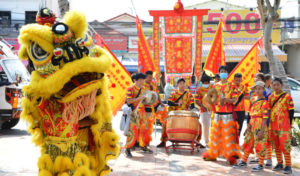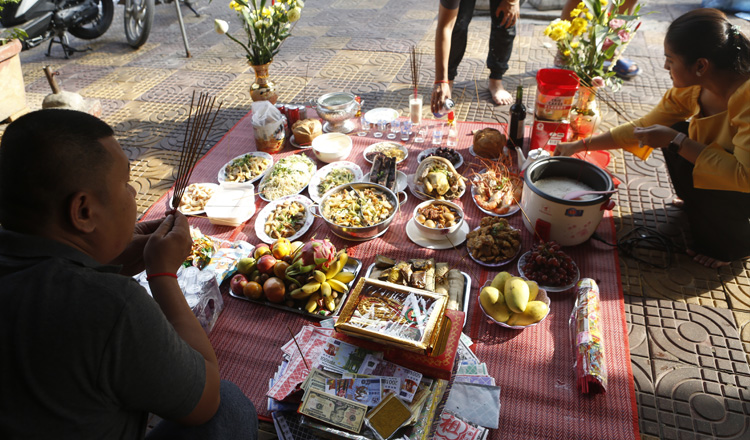HEADLINE: National: CNY- February 12 2021- All set for the Year of the Ox

Have you seen the lion or dragon dancing to the drum or heard the firecrackers? It’s the Chinese New Year celebration. However, it’s not in Beijing or Hong Kong. It’s right in Phnom Penh and other major cities and towns across Cambodia.
Let’s pretend you are also Chinese and enjoy the feast. It’s what many local Khmer people do.
Eang Nam, a 66-year-old Chinese Cambodian says about 90 people in his Kampong Cham province’s Prek Koy commune celebrate Chinese New Year. He says most of the Chinese New Year revellers are local Khmer people.
“Like other Chinese festivals, we offer food and wine to the spirits of our ancestors, grandparents, and parents to show our gratitude to them,” he says. “So, many local Khmer people follow us, because they also want to pay respect to their ancestors.

Nam says children of Chinese ancestry just follow what their grandparents and parents used to do the same way they followed the tradition of their ancestors.
“We feel that those who respect and are grateful to their ancestors seem to do a good business and live a good life,” he says.
Nam says Chinese Cambodians have also followed Khmer traditions such as the Khmer New Year in April and Pchum Ben festival in October.
“The Khmers celebrate their festivals to commemorate the spirits of their ancestors,” he says. “So, Chinese Cambodians have done the same so that we can have double respect and pay double gratitude to our ancestors.”

An Sovan, a 64-year-old Phnom Penh resident, says he shares a distant Chinese ancestry and mainly follows the local Khmer tradition and beliefs.
“How can you afford to celebrate Chinese New Year and hold other Chinese ceremonies, while celebrating Khmer New Year and hold other Khmer ceremonies at the same time?” he asks. “My salary is small, so I can’t follow both traditions.”
However, Sovan admits that his children do celebrate the Chinese New Year on a small scale based on their wealth.
“I don’t oppose them and let them offer food and wine to their ancient ancestors,” he says.
Nevertheless, Cambodian people of pure Khmer blood totally avoid celebrating the Chinese New Year or hold other Chinese ceremonies.

Bun Yon, a 63-year-old former Buddist monk in Kampong Cham province, says he never celebrates the Chinese New Year or hold other Chinese ceremonies.
“According to Buddhism, you need to offer food to the monks who pray to send religious merits to your ancestors,” he says. “Otherwise, your ancestors will not receive such merits.”
However, Yon says his Chinese Cambodian friends and neighbours would invite him and other local Khmer people for the party during the Chinese New Year.
“We would say “during the Chinese New Year, the fear is the Khmers also get drunk,” he says laughingly. “It’s no hard work just to go eat and drink.”
According to a historical document, the earliest records of Chinese settlement dates back to the late 13th century.
Yuan dynasty’s emissary Zhou Daguan visited Cambodia in 1296 and authored his detailed and comprehensive record of Cambodia in which he mentions the presence of Chinese residents at Angkor.


Later on, Portuguese seafarers noted the presence of a Chinese settlement in Phnom Penh in the early 17th century. Around the same time Lim To Khieng, a Chinese privateer, stayed in Cambodia while trading in the South China Sea.
According to the document, shortly after the fall of the Ming dynasty in 1644, Chinese troops under the command of Mac Cuu and Duong Ngan Dich encouraged large numbers of refugees from Fujian and Guangdong provinces to settle in Indochina.
“The majority of the immigrants were men who eventually married local Khmer women,” the documents state. “Their descendants usually assimilated smoothly into the local communities, the economic and social process and personally identified as Cambodians.”
According to the website “History”, Chinese New Year celebrations were born out of fear and myth. Legend spoke of the wild beast Nian (which also is the word for “year”) that appeared at the end of each year, attacking and killing villagers.
“Loud noises and bright lights were used to scare the beast away, and the Chinese New Year celebrations were born,” so says History. “Today, the 15-day New Year festivities are celebrated with a week of vacation in metropolitan areas of China.”
Much like the Western New Year (January 1st), the biggest celebration is on the eve of the holiday. At the turn of the New Year, firework displays are put on throughout the city.
Aside from New Year’s Eve, according to History, there are other important days of the 15-day Chinese New Year Festival, including:

JIE CAI CENG: Welcoming the Gods of Wealth and Prosperity
On the fifth day of New Year’s, it is believed that the gods of prosperity come down from the heavens. Businesses will often participate in setting off firecrackers as they believe it will bring them prosperity and good fortune for their business.
.

YUAN XIAO JIE: Festival of Lanterns
The 15th day of the New Year is known as the Festival of Lanterns and marks the end of the Chinese New Year celebrations. All types of lanterns are lit throughout the streets and often poems and riddles are often written for entertainment.
There are also paper lanterns on wheels created in the form of either a rabbit or the animal zodiac sign of the year (Ox for this year). The rabbit lantern stems from a Chinese myth or fairytale about a female goddess named Chang E who jumped onto the moon.
“So she wouldn’t travel alone, she brought a rabbit with her to keep her company,” explains the History. “It is said that if your heart is pure enough, you can see the goddess Chang E and her rabbit on the moon on this day.”


RED ENVELOPS:
Called “hong bao” in Mandarin, the red envelopes filled with money are typically only given to children or unmarried adults with no job. If you’re single and working and making money, you still have to give the younger ones the hong bao money.
“The colour red denotes good luck/fortune and happiness/abundance in the Chinese Culture and is often worn or used for decoration in other celebrations,” the website says.
.

DRAGON
The dragon is present in many Chinese cultural celebrations as the Chinese people often think of themselves as descendants of the mythical creature. On the fifth day of the New Year when many people have to start going back to work, they will also have dancing dragons perform in the front of the office building.
“On the 15th day of the New Year (Yuan Xiao Jie), they may also have a lot of dancing dragon performances,” the website notes. “The dragon represents prosperity, good luck and good fortune.”













